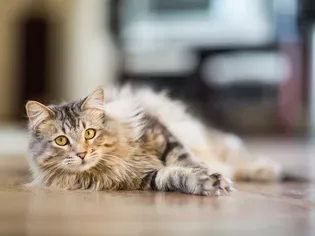What Is Scruffing in Cats?
Updated on 04/26/24

What Is Scruffing in Cats: A Comprehensive Guide
Scruffing is a technique that involves gently holding a cat by the loose skin at the back of their neck, which simulates the way a mother cat carries her kittens. It is a commonly used method to restrain cats for various purposes, such as administering medication, grooming, or performing veterinary procedures.
Understanding Scruffing
The scruff is a loose area of skin located on the back of a cat's neck, between the shoulder blades. This area is sensitive and instinctively triggers a calming response in cats. By holding the scruff, you essentially mimic the mother cat's grip, which creates a sense of security and reduces resistance.
Benefits of Scruffing
* Temporary immobilization: Scruffing can effectively immobilize cats for short periods, making it easier to handle them without causing undue stress or discomfort.
* Calming effect: The pressure on the scruff stimulates the release of oxytocin, a hormone that promotes relaxation and bonding. This can be particularly beneficial for anxious or aggressive cats.
* Restraint for procedures: Scruffing provides a safe and effective way to restrain cats for necessary procedures, such as giving injections, trimming nails, or examining their teeth.
How to Scruff a Cat
Materials:
* A thick towel or blanket
* A calm and confident demeanor
Steps:
1. Approach cautiously: Allow the cat to approach you and interact with you before attempting to scruff them.
2. Secure the towel: Place a thick towel or blanket over the cat's back, covering their body and head. The towel will help to muffle any sounds and reduce the cat's anxiety.
3. Position your hand: Gently slide your dominant hand underneath the cat's body, with your thumb and forefinger resting on the scruff.
4. Lift and support: Carefully lift the cat while supporting their weight with your other hand. Avoid lifting the cat too high, as this can cause discomfort.
Examples of Scruffing in Practice
* Administering medication: Hold the cat in a scruffed position while giving them oral medication or injections. The calming effect of scruffing can reduce resistance and make the procedure less stressful for the cat.
* Grooming: Use scruffing to gently restrain the cat while brushing their fur, trimming their nails, or cleaning their ears.
* Veterinary examinations: Veterinarians often use scruffing to immobilize cats during physical examinations, blood draws, or other procedures.
Precautions
* Use with caution: Scruffing should only be used when necessary and for short periods. Prolonged scruffing can cause pain or injury.
* Avoid excessive force: Apply gentle pressure to the scruff, only enough to restrain the cat safely.
* Know your cat: Observe your cat's body language and behavior to ensure that they are not distressed by scruffing.
* Respect the cat's boundaries: If a cat resists scruffing, do not force it upon them. Respect their boundaries and find alternative methods for restraint.
Conclusion
Scruffing is a valuable technique for temporarily immobilizing and calming cats. When performed correctly and with care, it can be a safe and effective way to handle cats for various purposes. However, it is essential to use this technique judiciously and with respect for the cat's well-being. By understanding the benefits, precautions, and examples of scruffing, you can ensure that this technique is used appropriately and effectively.
Explore More Pets

Cat Behavior Problems
How to Stop Aggression in Kittens

Long-Haired Cat Breeds
Siberian Cat: Breed Profile, Characteristics, & Care

Cat Behavior Problems
How to Stop Kittens From Scratching and Biting

Long-Haired Cat Breeds
Turkish Angora: Cat Breed Profile, Characteristics & Care

Basic Training
How to Socialize Your Kitten

Short-Haired Cat Breeds
Cute Pictures & Facts About Calico Cats & Kittens

Litter Box Training
Training Your Kitten to Use the Litter Box

Long-Haired Cat Breeds
10 Fun Facts About White Cats